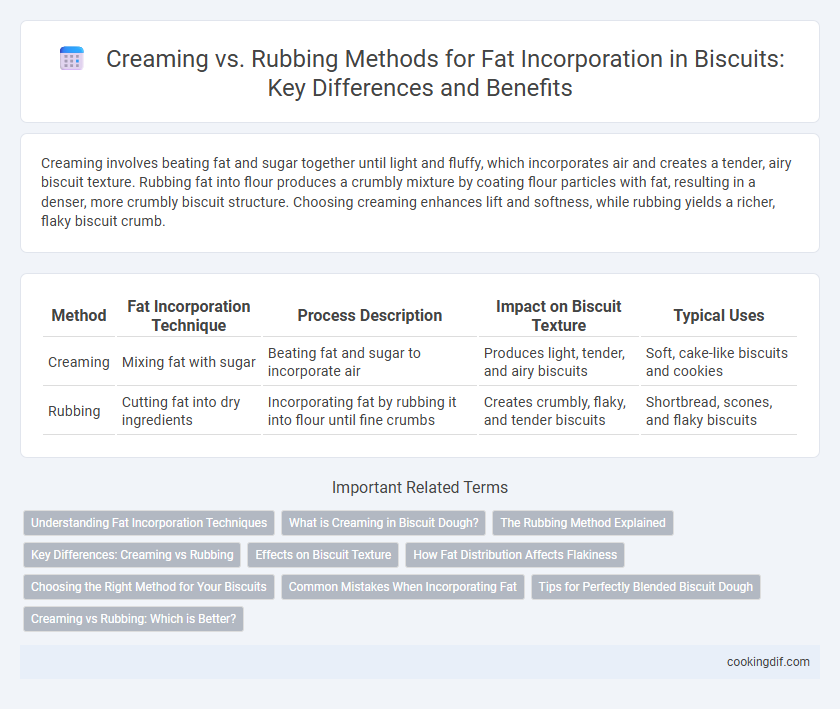Creaming involves beating fat and sugar together until light and fluffy, which incorporates air and creates a tender, airy biscuit texture. Rubbing fat into flour produces a crumbly mixture by coating flour particles with fat, resulting in a denser, more crumbly biscuit structure. Choosing creaming enhances lift and softness, while rubbing yields a richer, flaky biscuit crumb.
Table of Comparison
| Method | Fat Incorporation Technique | Process Description | Impact on Biscuit Texture | Typical Uses |
|---|---|---|---|---|
| Creaming | Mixing fat with sugar | Beating fat and sugar to incorporate air | Produces light, tender, and airy biscuits | Soft, cake-like biscuits and cookies |
| Rubbing | Cutting fat into dry ingredients | Incorporating fat by rubbing it into flour until fine crumbs | Creates crumbly, flaky, and tender biscuits | Shortbread, scones, and flaky biscuits |
Understanding Fat Incorporation Techniques
Creaming and rubbing are essential fat incorporation techniques in biscuit making, each influencing texture and crumb structure differently. Creaming involves beating fat with sugar until light and fluffy, trapping air for a tender, leavened biscuit. Rubbing fat into flour creates a coarse, crumbly texture by coating flour particles, preventing gluten development and resulting in a flaky biscuit.
What is Creaming in Biscuit Dough?
Creaming in biscuit dough involves beating fat, typically butter or shortening, with sugar until the mixture becomes light and fluffy, which helps incorporate air and creates a tender texture. This method ensures even fat distribution throughout the dough, resulting in a consistent crumb and enhanced moisture retention. Compared to rubbing, creaming produces a softer biscuit with a finer crumb structure due to the aeration process.
The Rubbing Method Explained
The rubbing method for fat incorporation in biscuit making involves grinding fat into flour using fingertips or a pastry cutter, creating a coarse, crumbly texture that promotes flakiness in the finished product. This technique ensures even distribution of fat without melting, which helps to retain pockets of fat that produce a tender, layered crumb structure. The rubbing method is ideal for biscuits requiring a light, airy texture as it prevents overworking the dough and maintains optimal fat-flour interaction.
Key Differences: Creaming vs Rubbing
Creaming and rubbing are two distinct methods of fat incorporation in biscuit making, each affecting texture and rise. Creaming involves beating fat and sugar together to incorporate air, resulting in a lighter, more aerated dough ideal for tender, flaky biscuits. Rubbing involves cutting fat into flour until the mixture resembles coarse crumbs, which limits air incorporation and produces denser, crumbly biscuits with a more rustic texture.
Effects on Biscuit Texture
Creaming fat with sugar introduces air into the biscuit dough, creating a light, tender texture with fine crumb structure. Rubbing fat into flour coats the flour particles, resulting in a crumbly, flaky biscuit texture due to inhibited gluten development. The choice between creaming and rubbing methods directly affects the biscuit's mouthfeel and structural integrity, influencing softness versus flakiness.
How Fat Distribution Affects Flakiness
Fat distribution during biscuit preparation critically influences flakiness, as larger, solid fat particles create steam pockets that separate dough layers. Creaming evenly blends fat with sugar, resulting in a tender texture but less distinct layers, while rubbing fat into flour retains larger fat bits that enhance flakiness. Proper fat incorporation techniques control moisture release and dough structure, optimizing the biscuit's light, flaky quality.
Choosing the Right Method for Your Biscuits
Creaming incorporates fat by beating it with sugar, creating a light, airy texture ideal for tender, flaky biscuits. Rubbing involves cutting cold fat into dry ingredients, producing a crumbly, denser biscuit suited for rustic or savory flavors. Selecting the right method depends on desired biscuit texture and recipe requirements, with creaming maximizing rise and rubbing enhancing crumb structure.
Common Mistakes When Incorporating Fat
Common mistakes when incorporating fat in biscuit dough include over-creaming, which leads to excessive air incorporation and tough texture, and under-rubbing, resulting in uneven fat distribution and coarse crumbs. Using butter that is either too cold or too warm can prevent proper blending, causing greasy spots or dry patches. Ensuring the right fat temperature and mixing method is crucial for achieving a tender and flaky biscuit.
Tips for Perfectly Blended Biscuit Dough
For perfectly blended biscuit dough, use creaming to incorporate fat with sugar, resulting in a light, airy texture ideal for sweet biscuits. Rubbing fat into flour, on the other hand, creates a crumbly mixture that promotes flakiness and tenderness, perfect for savory biscuits. Maintain a cold environment and avoid overmixing to ensure optimal fat distribution and tender crumb structure.
Creaming vs Rubbing: Which is Better?
Creaming incorporates fat by beating it with sugar until light and fluffy, creating air pockets that enhance biscuit texture and rise. Rubbing involves blending fat into flour until the mixture resembles coarse crumbs, promoting a tender and crumbly biscuit structure. Creaming is better for softer, more cake-like biscuits, while rubbing yields a flakier, melt-in-the-mouth crumb characteristic of traditional biscuits.
Creaming vs rubbing for fat incorporation Infographic

 cookingdif.com
cookingdif.com